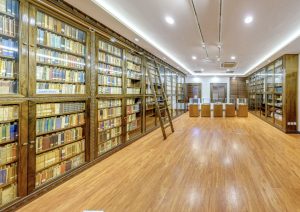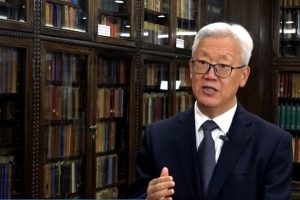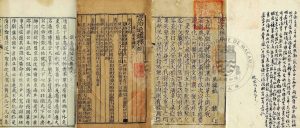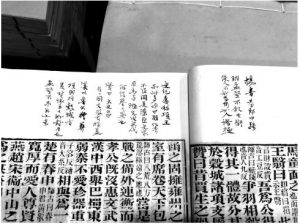Since the establishment of the Macao SAR, the University of Macau (UM) Library has seen remarkable growth in its collection of rare ancient books. The library’s repository has grown from an unnoticeable cabinet in a small room to an expansive and dedicated space. Some items in the collection are even classified as ‘national treasures’. We will explore the value of rare ancient books in contemporary times, and how scholars leverage the university’s collection for research.
Honouring the legacy of academic pioneers
A rare ancient book can encapsulate the vicissitudes of a dynasty or the life of a historical figure. In the UM Rare Book Collection Room, an extensive array of rare ancient books from both China and the West is elegantly displayed on intricately carved rosewood bookcases, representing a microcosm of civilisations in Macao.
The Rare Book Collection Room is situated in the middle of the Special Collection Area on the first floor of the UM Library. It houses treasures with a history of up to five centuries, including ancient mathematics books from the West, manuscripts from Portuguese envoys, and rare books from China’s Ming and Qing Dynasties. The room not only showcases magnificent global history, but also serves as a testament to Macao’s role as a bridge between Eastern and Western civilisations. Among the invaluable items, the 1491 incunabulum of Euclid’s Elements is particularly notable—it is the only incunabulum in China and one of only 84 copies held by libraries worldwide, highlighting its value.
‘If the library is the academic heart of the university, then the Rare Book Collection Room is its treasury vault, safeguarding the wisdom of the past,’ says Billy Leung, UM assistant university librarian. Billy joined UM in 1984 and has been actively involved in the development of the library over the years. He has also witnessed the transformation of the rare book collection from its initial lack of proper storage space to its meticulous preservation in a dedicated room. Billy is like a walking encyclopaedia; he can recount the story behind the acquisition of every item in UM’s rare book collection.
Billy adds, ‘Every item in the collection holds profound academic and cultural significance. The university places great importance on these rare ancient books. They not only preserve cultural heritage and promote academic development, but also serve to honour the legacy of academic pioneers from the past.’
Reflecting expectations for UM
UM’s Rare Book Collection Room houses an extensive array of ancient books, manuscripts, and unique collections, covering diverse academic fields, including history, literature, philosophy, science, and art. The significant expansion of the collection is not only the result of UM Library staff efforts, but also owes much to generous donations from members of society.
Among the donors, Ho Yin, a prominent leader of Macao’s Chinese community and the first chairman of the University Council of the University of East Asia (the predecessor of UM), is recognised as the most significant contributor to UM’s rare ancient book collection. Billy recalls that in the early 1980s, Mr Ho acquired rare books from Wang Zongyan (a descendant of Wang Zhaoyong, a politician in the late Qing Dynasty and early Republic of China), and specifically designated them for donation to the UM Library. This invaluable collection, totalling over 2,000 items, includes Lingnan literature and chronicles collected by Wang Zhaoyong, as well as the Twenty-Four Histories collected by the modern and contemporary Chinese painter Deng Fen. When donating these books, Mr Ho hoped that they would inspire young people in Macao to preserve the heritage of traditional Chinese culture and promote Macao’s academic development.
Another notable donor is Kan Lai Bing, former University Librarian of the University of Hong Kong, who passed away in September this year. On the upper shelves of the Western collection bookcase in the Rare Book Collection Room, one can find the 19th-century foreign language books donated by the University of Hong Kong Libraries. Billy recounts that these books were packed into six gunny sacks and shipped to UM from Hong Kong by sea in 1984. ‘However, due to the lack of suitable storage space on the old UM campus at that time, no one dared to open the sacks, so the books were put aside.’
This situation remained unchanged until the end of 1999. With the establishment of the Macao Special Administrative Region, UM embarked on a new phase of development. The university formed a special collection team to organise the rare books donated by various individuals and sectors of society. As a member of the team, Billy was tasked with the classification, cataloguing, and shelving of both Chinese and Western rare books. Subsequently, he took on responsibilities for the collection, preservation, and promotion of these books.
With UM’s growing reputation, the library has received more book donations from generous individuals. In early 2007, UM received a call from an individual who expressed his wish to donate his book collection to the university before passing away. This person was Chen Weiheng, a scholar of Macao history and culture, as well as a reporter of Macao Daily News during the 1980s. Chen had amassed a collection of more than 500 types of rare books, totalling 1,022 items. Among them, 120 items are directly related to the history of Macao and cover fields including opera, art, and religion, reflecting the historical changes of Macao from the Ming Dynasty to the late Qing Dynasty. Billy recalls Mr Chen’s final wish for these rare books to be properly preserved at UM, hoping they would support future academic research and generate greater value.
At that time, there was already a rare book room in the old UM campus library, situated in a corner of the facility. Despite this, Billy notes that the precious materials donated by generous members of society motivated the establishment of the Rare Book Collection Room on UM’s current campus in Hengqin. This room not only serves as a repository for these invaluable collections but also reflects the high expectations held by members of the local society for UM’s status as an international university.
Distinctive feature of the library
From a modest cabinet in a small room on the old campus to an expansive and dedicated space, the UM Rare Book Collection Room has experienced remarkable development. Currently, the room boasts more than 35,000 rare books, including more than 100 types of fine editions of rare books from the Ming and Qing Dynasties. Wu Jianzhong, former director of Shanghai Library, has served as the UM University Librarian since 2018. He is dedicated to enhancing the university’s book collections and actively seeks to acquire more rare books to further enrich the library’s distinctive characteristics.
According to Dr Wu, after 25 years of continuous exploration, the UM Library has established standards for its rare book collection that reflect the characteristics of UM. These standards include: 1) Collecting materials with local characteristics, such as literature on the history and culture of China or Macao, in order to promote cultural inheritance; 2) Acquiring resources that meet the needs of the academic disciplines at UM, prioritising literature that supports the academic and research development of the university; 3) Acquiring rare materials, including unique copies and fine editions of rare books, to honour the legacy of predecessors.
In terms of rare Chinese books, three block-printed books from the Ming Dynasty stand out as particularly representative: ‘Newly Compiled and Annotated External Chronicles of ‘Zizhi Tongjian’ (新編纂註資治通鑑外紀義), ‘Revised and Corrected Anthology of Tang Literature’ (重校正唐文粹), and ‘Collected Works of Duke Zong Zhongjian’ (宗忠簡公文集). These books, each over 500 years old, are remarkably well-preserved and in excellent condition. They also contain stamps from renowned ancient artists and well-organised postscripts, making them invaluable for the study of cultural relics, history, and cultural values. Recognised for their significance, these three ancient books have been included in the ‘National Catalogue of Precious Ancient Books’ by the State Council and the Ministry of Culture and Tourism. In addition, they have been selected by the Centre for Preservation and Conservation of Ancient Books of Guangdong Province for inclusion in the ‘Guangdong-Hong Kong-Macao Greater Bay Area National Rare Ancient Book Directory’, underscoring their status as ‘national treasures’.
The rare book collection also features distinctive works from the West. Notable examples include Historia de las Cosas mas Notables, Ritos y Costumbres, del Gran Reyno dela China (in Spanish), the first book to systematically, objectively, and comprehensively describe various aspects of China in the 16th century from a European perspective. Another significant work is De Christiana expeditione apvd. Sinas svscepta ab Societate Iesv (in Latin), which details the experiences of the Italian Jesuit missionary Matteo Ricci in China. In addition, Um raro manuscrito Português contendo o relatόrio oficial da Embaixada do Rei D. Joᾶo V de Portugal ao Imperador Yongzheng em 1725-1728: Cerímόnía de Apresentação (in Portuguese) details the itinerary of a Portuguese ambassador between Macao and Lisbon. All of these books are of great significance to the study of early Sino-Portuguese relations.
Sharing resources with the public
In addition to striving to collect additional rare Chinese and Western books, the UM Library is also dedicated to sharing its resources with the public to promote the academic and cultural value of rare books. During the initial stages, cataloguing these books was challenging because there was a large number of rare books and many of the Chinese books lack publication dates, making it difficult to determine whether they were from the Ming or Qing Dynasty. Besides, some books contained incorrect publication information. To address these issues, it was essential for experts to meticulously verify and classify each book to ensure the accuracy of the bibliographic records.
In 2005, the special collection team collaborated with Prof Tang Chon Chit from the UM Department of Chinese Language and Literature to undertake this challenging task. They scrutinised each book for any clues that might indicate the year of publication. They made significant progress under Prof Tang’s guidance and efforts, leading to the publication of Images of UM Rare Books in 2006. This resource not only facilitates faculty and student searches for rare materials, but has also played a crucial role in promoting rare book culture.
As the influence of UM’s rare Chinese book collection on academia continued to grow, the UM Library collaborated with the National Library of China Publishing House to launch the ‘Collection of Chinese Rare Ancient Books from the University of Macau’ (twelve volumes) in 2015. This series was the first edition of ‘Collection of Chinese Rare Ancient Books’ launched by a library outside mainland China.
Over the years, the UM Library has put substantial effort into organising its rare Chinese and Western books. Each year, many overseas experts and scholars travel to Macao to access the materials in the Rare Book Collection Room, seeking to discover gaps and potential breakthroughs in academic research.
Providing invaluable teaching and research resources
As vital links between the past and present, rare books possess academic value far beyond what one might imagine. They not only promote research across various disciplines, but also provide invaluable teaching and learning resources for faculty and students. More than just a repository, the UM Rare Book Collection Room enables scholars to trace historical origins and reconstruct narratives. Moreover, this space is an educational venue which sparks students’ academic curiosity.
Department of History classes are often held in the Rare Book Collection Room, which allows students to have direct access to relevant materials, thus enhancing their understanding and engagement in historical studies. Prof Li Ping is one of the faculty members who particularly enjoys teaching in this environment, especially when discussing the Twenty-Four Histories of China. This is because UM houses a complete edition of the Twenty-Four Histories published during the Qing Dynasty by five provincial publishing houses. Encompassing all historical works from Records of the Grand Historian to History of Ming, the collection provides a wealth of historical information that deepens students’ understanding of Chinese history.
Prof Li and one of his doctoral students have conducted a study on this special version of the Twenty-Four Histories acquired by the UM Library. He notes that many other versions of the Twenty-Four Histories are in circulation, with the UM Library housing four versions in total. Throughout their research, they also referred to reflections and annotations by renowned writers found in different versions of the collection.
Many UM scholars working in the area of social sciences have also leveraged rare materials to gain new perspectives on China-foreign relations and the history of Macao. For example, Agnes Lam, associate professor in the Department of Communication, has focused on the interplay between media and society in an examination of the modern history of Chinese media through the lens of the Christian movement. Her study on Macao’s press history, approached from a micro perspective, was also facilitated by the resources in the Rare Book Collection Room.
Living up to expectations
Rare books are invaluable treasures, and their value lies in being preserved for future generations. Since its establishment, the UM Rare Book Collection Room has been committed to upholding the cultural spirit of these rare ancient books, ensuring their benefit for faculty and students. Moreover, the UM Library has digitised a significant collection of invaluable rare Chinese and Western books, allowing the public, experts and scholars to access these resources online, thereby promoting the culture of rare books.
University Librarian Dr Wu emphasises, ‘The Rare Book Collection Room will live up to expectations and remain committed to its mission: to support faculty and students in their academic pursuits, and to preserve the value of rare ancient books’.
Text: Kelvin U, Trainee UM Reporter Huang Ka Wing, Tang Chenyimin, Hong Yuting
English translation: Bess Che
Photos: Editorial Board, with some provided by the interviewees
Source: My UM Issue 137

The Rare Book Collection Room, situated on the first floor of the UM Library

Dr Wu Jianzhong

These three rare Chinese books are recognised as ‘national treasures’

Prof Li Ping and his doctoral student have conducted a study on the version of the Twenty-Four Histories published during the Qing Dynasty by five provincial publishing houses, whi

Prof Agnes Lam completed her book The Beginning of the Modern Chinese Press History: Macau Press History by leveraging materials from the Rare Book Collection Room
